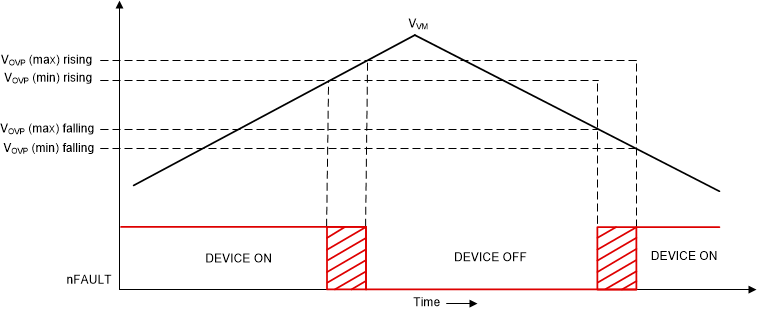SLVSH86A December 2023 – June 2024 MCT8314Z
PRODUCTION DATA
- 1
- 1 Features
- 2 Applications
- 3 Description
- 4 Device Comparison Table
- 5 Pin Configuration and Functions
- 6 Specifications
-
7 Detailed Description
- 7.1 Overview
- 7.2 Functional Block Diagram
- 7.3
Feature Description
- 7.3.1 Output Stage
- 7.3.2 PWM Control Mode (1x PWM Mode)
- 7.3.3 Device Interface Modes
- 7.3.4 AVDD Linear Voltage Regulator
- 7.3.5 Charge Pump
- 7.3.6 Slew Rate
- 7.3.7 Cross Conduction (Dead Time)
- 7.3.8 Propagation Delay
- 7.3.9 Pin Diagrams
- 7.3.10 Automatic Synchronous Rectification Mode (ASR Mode)
- 7.3.11 Cycle-by-Cycle Current Limit
- 7.3.12 Hall Comparators (Analog Hall Inputs)
- 7.3.13 Advance Angle
- 7.3.14 FG Signal
- 7.3.15
Protections
- 7.3.15.1 VM Supply Undervoltage Lockout (NPOR)
- 7.3.15.2 AVDD Undervoltage Lockout (AVDD_UV)
- 7.3.15.3 VCP Charge Pump Undervoltage Lockout (CPUV)
- 7.3.15.4 Overvoltage Protections (OVP)
- 7.3.15.5 Overcurrent Protection (OCP)
- 7.3.15.6 Motor Lock (MTR_LOCK)
- 7.3.15.7 Thermal Warning (OTW)
- 7.3.15.8 Thermal Shutdown (OTS)
- 7.4 Device Functional Modes
- 7.5 SPI Communication
- 8 Register Map
- 9 Application and Implementation
- 10Device and Documentation Support
- 11Revision History
- 12Mechanical, Packaging, and Orderable Information
Package Options
Mechanical Data (Package|Pins)
- RRW|24
Thermal pad, mechanical data (Package|Pins)
Orderable Information
7.3.15.4 Overvoltage Protections (OVP)
If at any time input supply voltage on the VM pins rises higher than the VOVP threshold voltage, all of the integrated FETs are disabled and the nFAULT pin is driven low. The FAULT and OVP bits are also latched high in the registers on SPI devices. Normal operation starts again (driver operation and the nFAULT pin is released) when the OVP condition clears. The OVP bit stays set until cleared through the CLR_FLT bit or an nSLEEP pin reset pulse (tRST). Setting the OVP_EN bit high on the SPI device (MCT8314ZS) enables this protection feature. The OVP threshold is also programmable on the SPI device variant and can be set to 22-V or 34-V based on the OVP_SEL bit. On hardware interface device (MCT8314ZH), the OVP protection is always enabled and set to a 34-V threshold.
 Figure 7-31 Over Voltage Protection
Figure 7-31 Over Voltage Protection